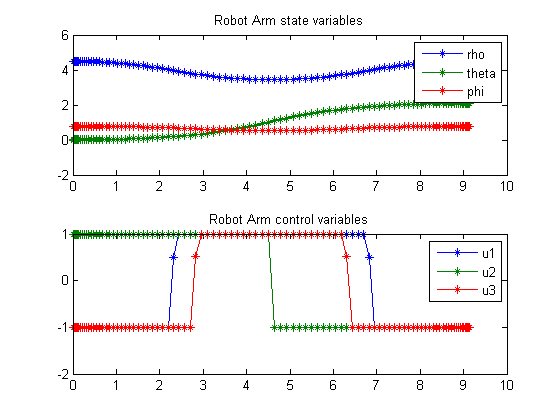Robot Arm Movement
Benchmarking Optimization Software with COPS Elizabeth D. Dolan and Jorge J. More ARGONNE NATIONAL LABORATORY
Contents
Problem Formulation
Find u(t) over t in [0; 1 ] to minimize

subject to:









The boundary conditions are:
![$$ [rho_0 \ theta_0 \ phi_0] = [4.5 \ 0 \ \frac{pi}{4}] $$](xrobotArmMovement_eq07436.png)
![$$ [rho_1 \ theta_1 \ phi_1] = [4.5 \ \frac{2*pi}{3} \ \frac{pi}{4}] $$](xrobotArmMovement_eq40536.png)

All first order derivatives are 0 at boundaries.
% Copyright (c) 2007-2008 by Tomlab Optimization Inc.
Problem setup
toms t toms tf % Initial guess tfopt = 1; x1opt = 4.5; x2opt = 0; x3opt = 2*pi/3*t.^2; x4opt = 0; x5opt = pi/4; x6opt = 0; u1opt = 0; u2opt = 0; u3opt = 0; for n=[20 100]
%rho d(rho)dt theta d(theta)dt phi d(phi)dt p = tomPhase('p', t, 0, tf, n); setPhase(p); tomStates x1 x2 x3 x4 x5 x6 tomControls u1 u2 u3 % Initial guess x0 = {tf == tfopt icollocate({x1 == x1opt x2 == x2opt; x3 == x3opt x4 == x4opt; x5 == x5opt x6 == x6opt}) collocate({u1 == u1opt u2 == u2opt; u3 == u3opt})}; % Box constraints L = 5; cbox = { 0.1 <= tf <= 10 0 <= icollocate(x1) <= L -pi <= icollocate(x3) <= pi 0 <= icollocate(x5) <= pi -1 <= collocate(u1) <= 1 -1 <= collocate(u2) <= 1 -1 <= collocate(u3) <= 1}; % Boundary constraints cbnd = {initial({x1 == 4.5; x2 == 0 x3 == 0; x4 == 0 x5 == pi/4; x6 == 0}) final({x1 == 4.5; x2 == 0 x3 == 2*pi/3 x4 == 0 x5 == pi/4 x6 == 0 })}; I1 = ((L-x1).^3+x1.^3)./3.*sin(x5).^2; I2 = ((L-x1).^3+x1.^3)/3; % ODEs and path constraints ceq = collocate({dot(x1) == x2 dot(x2) == u1/L; dot(x3) == x4 dot(x4) == u2./I1; dot(x5) == x6 dot(x6) == u3./I2}); % Objective objective = tf;
Solve the problem
options = struct;
options.name = 'Robot Arm';
solution = ezsolve(objective, {cbox, cbnd, ceq}, x0, options);
% Optimal x, y, and speed, to use as starting guess in the next iteration
x1opt = subs(x1, solution);
x2opt = subs(x2, solution);
x3opt = subs(x3, solution);
x4opt = subs(x4, solution);
x5opt = subs(x5, solution);
u1opt = subs(u1, solution);
u2opt = subs(u2, solution);
u3opt = subs(u3, solution);
tfopt = subs(final(t), solution);
Problem type appears to be: lpcon
===== * * * =================================================================== * * *
TOMLAB - Tomlab Optimization Inc. Development license 999001. Valid to 2010-02-05
=====================================================================================
Problem: --- 1: Robot Arm f_k 9.146367586242577700
sum(|constr|) 0.000001641938376501
f(x_k) + sum(|constr|) 9.146369228180955000
f(x_0) 1.000000000000000000
Solver: snopt. EXIT=0. INFORM=1.
SNOPT 7.2-5 NLP code
Optimality conditions satisfied
FuncEv 1 ConstrEv 15 ConJacEv 15 Iter 10 MinorIter 267
CPU time: 0.093750 sec. Elapsed time: 0.093000 sec.
Problem type appears to be: lpcon
===== * * * =================================================================== * * *
TOMLAB - Tomlab Optimization Inc. Development license 999001. Valid to 2010-02-05
=====================================================================================
Problem: --- 1: Robot Arm f_k 9.140854009735496900
sum(|constr|) 0.000002639173276572
f(x_k) + sum(|constr|) 9.140856648908773300
f(x_0) 9.146367586242577700
Solver: snopt. EXIT=0. INFORM=1.
SNOPT 7.2-5 NLP code
Optimality conditions satisfied
FuncEv 1 ConstrEv 7 ConJacEv 7 Iter 4 MinorIter 723
CPU time: 1.828125 sec. Elapsed time: 1.828000 sec.
end
t = subs(collocate(t),solution);
x1 = subs(collocate(x1),solution);
x3 = subs(collocate(x3),solution);
x5 = subs(collocate(x5),solution);
u1 = subs(collocate(u1),solution);
u2 = subs(collocate(u2),solution);
u3 = subs(collocate(u3),solution);
Plot result
subplot(2,1,1) plot(t,x1,'*-',t,x3,'*-',t,x5,'*-'); legend('rho','theta','phi'); title('Robot Arm state variables'); subplot(2,1,2) plot(t,u1,'*-',t,u2,'*-',t,u3,'*-'); legend('u1','u2','u3'); title('Robot Arm control variables');
